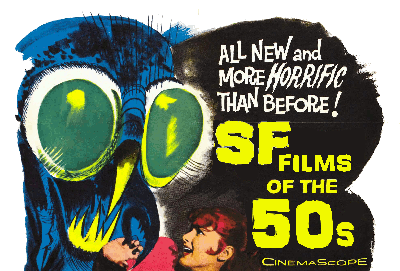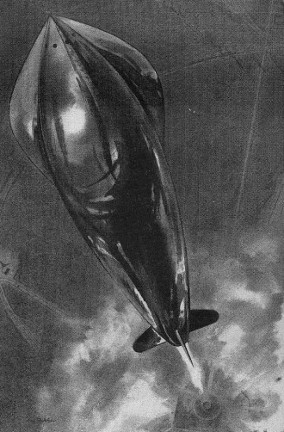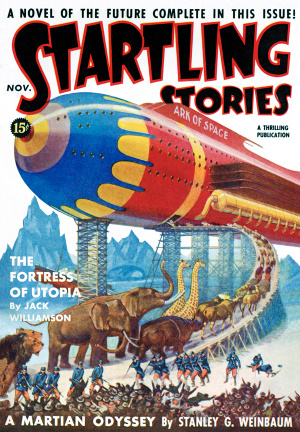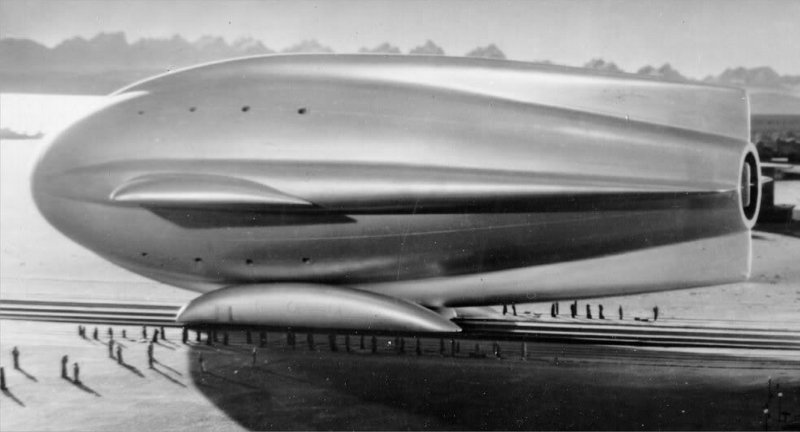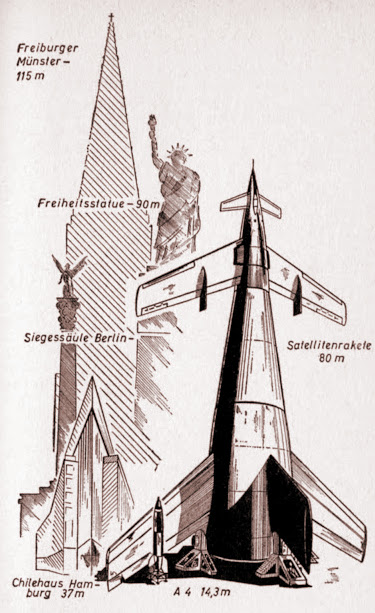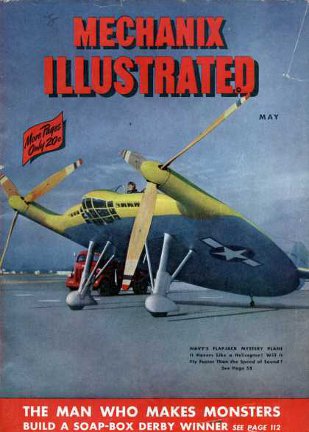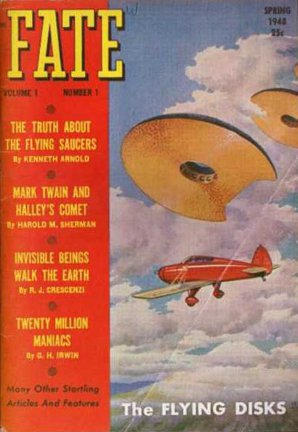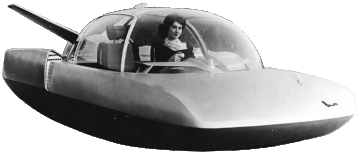CLICK HEADER IMAGE TO RETURN TO MAIN PAGE
SPACESHIPS
BASICS
Assertions here are those of SFFot50s.
Among appeals of sf movies is visualization of spaceships and other vehicles.
Space is, generally, volume between stars not part of a planet, 50s rule of thumb was space began 50 miles up. Any vehicle designed to operate in space is a spaceship.
They break down into 3 categories by appearance: Rocket shaped, saucer shaped, and other.
ROCKETS
That rockets are the essential machine for space travel is an understanding as old as the 20th Century. That a practical rocket engine is roughly a cylinder longer than it is wide is dictated by physics--if nothing added to that for whatever motivation disguises this basic shape it is "rocket shaped."
LAST BLAST OF THE 1940s
Attention to space flight spread to general population post-WWII, Noel Sickels painted this 2-stage rocket headed for the Moon for LIFE magazine in 1949.
LEFT - pulp cover STARTLING STORIES Nov 1939
RIGHT - movie still WELTRAUMSCHIFF (short, GER 1937)
Bullet-like V-2 rocket ballistic missile and Leduc 0.10 ramjet airplane projects were both begun in mid 30s and were operational in mid 40s. They both are engines with enough added to fly to spec. Both seem to echo practical fictional designs predating them.
Bulbous Art Deco spaceships of both 30s pulp and film crossed with the proven real-life V-2 and Leduc seemed to lead to two classic fictional compromise designs typified by 1950's Destination Moon's 'Luna' and Rocketship X-M's 'X-M.' 'Luna' had winglike fins suggesting atmospheric flight, 'X-M' small ballistic fins.
Had pulp covers and HOOD ORNAMENTS escaped sf movie makers' notice, there was Life magazine’s ‘Rocket to the Moon’ (with Noel Sickels art of 2-stage rocket) in 1949 and much ballyhoo around Destination Moon in 1950. A 1950 Life magazine article featured both movie stills and Bonestell art.
Later, as actual space exploration began and actual space scientists speculated publicly about the future, came a realistic strain in sf spaceship design. Collier's magazine's 1952-54 space flight articles had the imprimatur of the V-2's Wernher von Braun and other rocket engineers and scientists. Von Braun introduced the 3-stage Ferry Rocket there and kept showcasing it until NASA went with cruder cheaper approaches as the decade ended.
The first two Ferry Rocket stages were ballistic, the third plane-like in that it would return to Earth's surface as would the aborted Dynasoar and the Space Shuttle. A film version of the Ferry Rocket appears to good effect occasionally (instances noted).
Many of the more utilitarian craft postulated by real life experts informed some sf film designers' Earth-origin ships among the category of OTHER--1953's Project Moonbase has some.
STOCK FOOTAGE paralleled real life progress, beginning with government footage of V-2 launches (even in films in which hood ornament rockets completed the flight--although in some the film spaceship was designed to resemble a V-2) and later including various sounding rockets and early big payload birds--although V-2 footage was used hither and thither throughout the 50s.

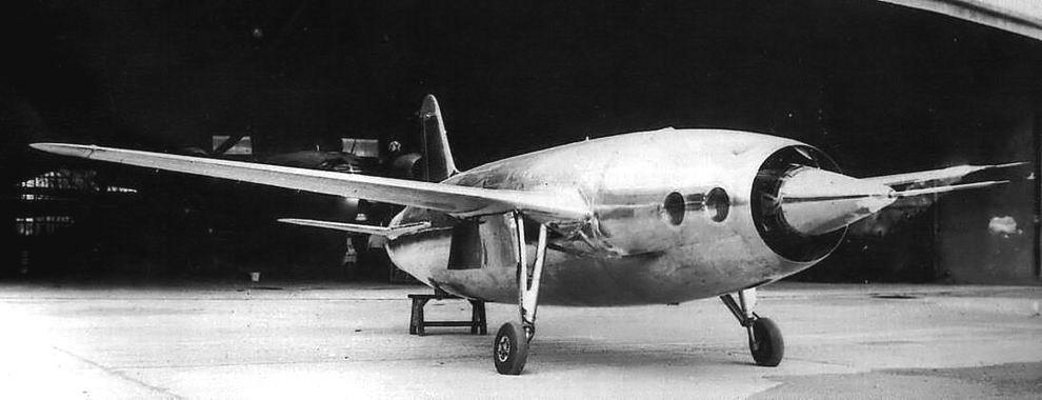
LEFT - WWII German launch of V-2 ballistic rocket, V-2s were capable of entering space.
BELOW - Leduc 0.10 ramjet plane, 1947. Designed for maximum speed, engine fills fuselage with space reserved for pilot.
LEFT - 53 kid's nonfiction book illo of 3-stage Ferry Rocket, orbital spaceship championed by von Braun throughout 50s. One was on cover of initial Collier's article on space fight in 52.
Von Braun demo'd a 4-stager in a Disney TV show in 1955, that and 2 other shows (1955-57) featured other real life possibilities for craft and space stations which informed film designers from the mid 50s until at least 2001: A SPACE ODYSSEY (1968).
In general, the legacy of flight through Earth's atmosphere is shown in sf film
rockets' primary attitude in flight in the direction of its axis (height), a flying
saucer's in its radius.
SAUCERS
Flying saucers, prototypical UFOs, entered the popular mind in 1947 following
genuine news reports of alleged sightings--whether the iconic design was an
accurate visual of what had been allegedly sighted became moot.
Previous fictional designs, as with those of rockets, included many quite bulky
ones--one could derive a full range from stubby versions of rockets to sleeker ones
which looked a great deal like the real-life Flying Flapjack airplane of 1947.
Saucer shaped spaceships might, but not necessarily, use rockets for propulsion.
Some spin like tops, some do not. Perhaps tellingly first 50s film use of flying
saucer incorporates a completely prosaic explanation, and in sf and non-sf films
and TV the term "flying saucer" is often used synonymously with "nut-case."
But saucers are great!
SCIENCE FACT 1947
SCIENCE FANTASY 1948
YET TO COME -- DETAILS ABOUT 'OTHER' SPACESHIP SHAPES
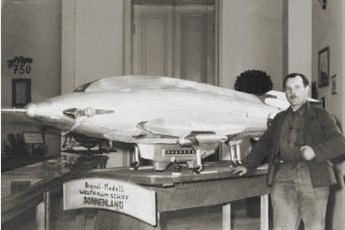
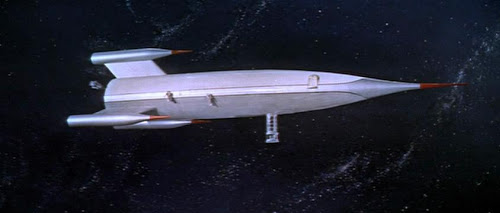
KARL HANS JANKE
Karl Hans Janke, 1909-1988, was evidently at minimum a workman-like mechanic and
inventor whose career was affected by mental health factors but whose output of
pleasing drawings and models of speculative devices and vehicles, including
airplanes and rocket shaped spaceships, was phenomenal in its volume and in that he
produced it during roughly 40 years of being committed to Hubertusberg, a mental
health institution (1950-1988).
His works were not unknown but not widely known during his lifetime. His works were
exhibited at least once, in 1958, in the hospital in which he was then committed,
he also gave slide presentations there, but it is only after an initial 2001
curated presentation of some of the rediscovered stored material that the multiple
crate loads of thousands of drawings and some models began creeping into wider
consciousness.
His primary motif seems to have been a reliance on a free energy source which he
assumed existed, his assumption being on the order of a Tesla-enthusiast's--
unsourced and unsupportable but breezily incorporated into his designs.
For SFFot50s his works are singular in that they are seemingly informed by the
early hard science rocketry movement of mittel-Europe, pulp and film depictions of
future technology, and real life implementation of same, yet having no known
interaction with any of that--and his most elaborate spaceships being either
concurrent with or seemingly inspiration for some of the most satisfying of sf film
ships.
A paramount example is the 'Stardust' of Satellite in the Sky 1956.
His monomania for rational depictions of machines, both their skins and innards,
which should populate (and form!) the future have won him a special place in the
heart of SFFot50s.
Janke with 'Sonnenland,' possibly mid 50s pic but date of design/construction
unclear. Reportedly formal in manner and dress, work clothes possibly are expression of his
self view.
'Stardust,' Satellite in the Sky 1956, expressive combo of 50s streamlining with
a bow to physics--in the film its flight possible owing to powerful rocket fuel
which will forever remain fictional. Film also has scenes with real life 50s Avro
Vulcan and Folland Midge jet aircraft.
